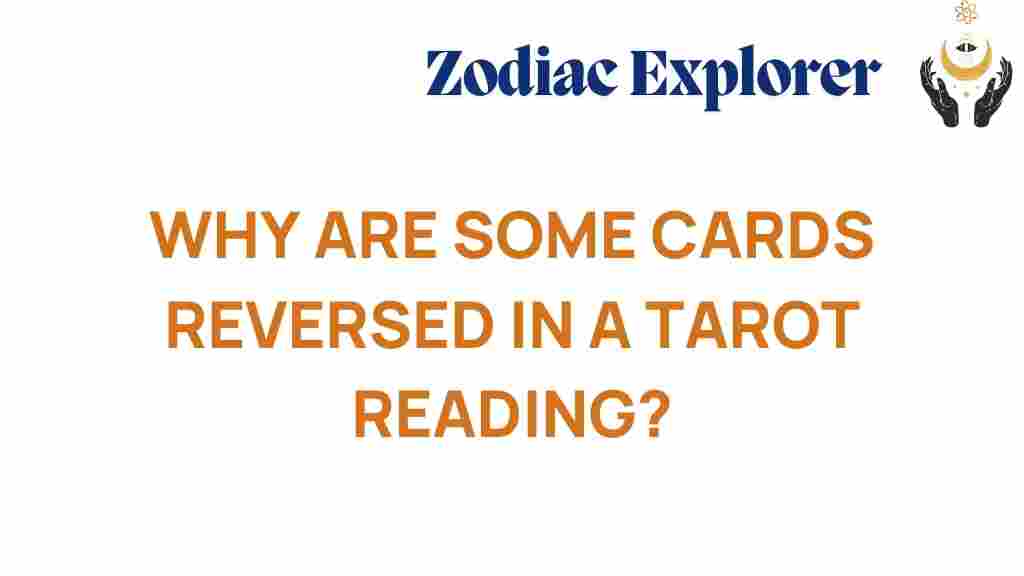Unveiling the Mystery: Why Are Some Cards Reversed in Tarot Readings?
Tarot reading is an ancient form of divination that utilizes a deck of cards to provide insights, guidance, and predictions regarding various aspects of life. One of the intriguing elements of tarot reading is the presence of reversed cards. In this article, we will explore the significance of reversed cards in tarot, their symbolism, interpretations, and how they can affect your readings.
The Basics of Tarot and Reversed Cards
Before diving into the specifics of reversed cards, let’s briefly discuss what tarot is. Tarot consists of a set of 78 cards, divided into the Major Arcana and Minor Arcana. Each card carries its own meanings, symbols, and interpretations that can provide significant insights into the querent’s life.
When a card appears reversed in a tarot reading, it means that it is turned upside down. This orientation can alter the meaning of the card significantly, often indicating a different or opposing energy. Understanding how to interpret these reversed cards is crucial for any tarot reader.
Understanding the Symbolism of Reversed Cards
Reversed cards can symbolize various concepts, including:
- Blockages: The energy of the card may be blocked or hindered.
- Inner Reflection: A call to look inward rather than outward.
- Opposition: The opposite of the upright meaning may apply.
- Delays: A sign that progress may be stalled.
- Warnings: Potential pitfalls or negative aspects to be aware of.
Each reversed card can carry its own unique symbolism, which is essential to consider in the context of the reading.
Interpreting Reversed Cards in Tarot Reading
Interpreting reversed cards requires a nuanced understanding of both the original meaning of the card and the intention behind the reading. Here’s a step-by-step process for interpreting reversed cards:
Step 1: Know the Upright Meaning
Before you interpret a reversed card, familiarize yourself with its upright meaning. For instance:
- The Fool (upright): New beginnings, adventure, spontaneity.
- The Death (upright): Transformation, endings, and new beginnings.
- The Chariot (upright): Control, willpower, and triumph over obstacles.
Step 2: Analyze the Reversal
Once you know the upright meaning, consider how reversing the card might change its interpretation. For example:
- The Fool (reversed): Recklessness, naivety, or poor judgment.
- The Death (reversed): Resistance to change, stagnation, or fear of endings.
- The Chariot (reversed): Lack of control, directionlessness, or aggression.
Step 3: Contextualize the Card
Always consider the context of the reading. The surrounding cards and the question being asked can greatly influence the meaning of a reversed card. For instance, if the Chariot is reversed but surrounded by positive cards, it might suggest a temporary setback rather than a permanent state.
Step 4: Reflect on Intuition
Intuition plays a vital role in tarot reading. Trust your instincts when interpreting reversed cards. Sometimes, a card might resonate with a personal experience or insight that you can draw upon to provide a deeper understanding.
Common Misconceptions About Reversed Cards
There are several misconceptions about reversed cards in tarot reading:
- Reversed cards are always negative: While many reversed cards indicate challenges or difficulties, they can also represent necessary lessons or personal growth.
- Reversed cards should be avoided: Some readers choose not to use reversed cards at all. However, they can provide valuable insights and should not be ignored.
- Understanding reversed cards is too complex: While it requires practice, mastering the interpretation of reversed cards can enhance your readings and deepen your understanding of tarot.
Troubleshooting Common Issues When Reading Reversed Cards
During your tarot journey, you may encounter challenges when interpreting reversed cards. Here are some troubleshooting tips:
Tip 1: Keep a Tarot Journal
Document your readings, including reversed cards. Note the context, your interpretations, and how the reading resonated with the querent. This practice can help you refine your skills.
Tip 2: Use Intuitive Techniques
If you find it hard to interpret a reversed card, try free association. Write down the first words or feelings that come to mind when you see the card reversed.
Tip 3: Consult Tarot Resources
Many books and online resources provide detailed interpretations of reversed cards. Consider checking out reputable tarot websites or literature to expand your understanding. A great resource is Tarot.com, which offers valuable insights into tarot symbolism and meanings.
Tip 4: Practice Regularly
The more you practice, the more comfortable you will become with interpreting reversed cards. Consider doing daily draws and incorporating reversed cards into your practice.
Conclusion
Reversed cards in tarot readings are not merely obstacles or negative forces; they are powerful tools for insight and reflection. By understanding the symbolism and meanings behind these cards, you can enhance your tarot readings and provide more accurate interpretations.
Whether you are a seasoned tarot reader or a beginner, embracing the complexity of reversed cards can lead to deeper insights into your readings. Remember that the journey of tarot reading is about exploring both the light and shadow aspects of life, allowing the cards to guide you toward greater understanding and clarity.
For further exploration of tarot and its meanings, consider visiting Biddy Tarot, a comprehensive resource for tarot enthusiasts.
This article is in the category Myths and created by ZodiacExplorer Team
